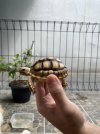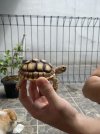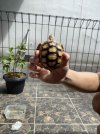You are using an out of date browser. It may not display this or other websites correctly.
You should upgrade or use an alternative browser.
You should upgrade or use an alternative browser.
Is This considered Pyramiding? (Help and advise please)
- Thread starter Roma D Irama
- Start date
I'm not a senior yet, but I can help. Yes, that is pyramiding. If that is the tortoises enclosure in the back ground of your picture, then we know right away why the tortoise is pyramiding.
Read this for the correct housing, lighting and care info:
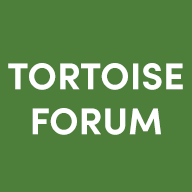 tortoiseforum.org
tortoiseforum.org
Read this for the correct housing, lighting and care info:
The Best Way To Raise A Sulcata, Leopard, Or Star Tortoise
I chose the title of this care sheet very carefully. Are there other ways to raise babies? Yes. Yes there are, but those ways are not as good. What follows is the BEST way, according to 30 years of research and experimentation with hundreds of babies of many species. Babies hatch during the...
- Joined
- Nov 17, 2013
- Messages
- 3,414
The short answer to your question is yes, it is pyramiding.Hi All,
I am a new owner for a sulcata around 7-8cm
I was wondering if any senior here could help me identify if my sulcata is pyramiding?
i can't help but wondering if its normal.
Really appriciate for your replies
View attachment 341369View attachment 341370View attachment 341371View attachment 341372
Following the care in the link posted by Tom will help you keep it from getting worse.
in their home world (where they've evolved to live) Sulcata babies hatch out during the monsoon season. . . lots of warm, humid air, plenty of green plants and water puddling on the ground. This is NOT the desert-like environment we were told to keep them in.
So get your baby out of the desert and set him up in a warm, humid, full-of-plants environment. You can't make that pyramiding go away, but you CAN help it to not get any worse.
So get your baby out of the desert and set him up in a warm, humid, full-of-plants environment. You can't make that pyramiding go away, but you CAN help it to not get any worse.
Ditto on all the posts above.
If you catch it when they are this little giving them the right humidity can reduce the appearance of pyramiding as they age and their shell grows. Also, make sure that to give him the healthiest foods and no fruit until adulthood. And then only very limited quantities of fruit if it's allowed on the sulcata food list.
Roma D Irama
New Member
Hi Tom,I'm not a senior yet, but I can help. Yes, that is pyramiding. If that is the tortoises enclosure in the back ground of your picture, then we know right away why the tortoise is pyramiding.
Read this for the correct housing, lighting and care info:
The Best Way To Raise A Sulcata, Leopard, Or Star Tortoise
I chose the title of this care sheet very carefully. Are there other ways to raise babies? Yes. Yes there are, but those ways are not as good. What follows is the BEST way, according to 30 years of research and experimentation with hundreds of babies of many species. Babies hatch during the...tortoiseforum.org
Thank you for your respond,
Does it considere severe pyramiding?
no it is not his/her enclousure, it's enclosure as per attachment,
that is the area where i normally bask him ofcourse with his/her enclousure as per attachment minus the lights till afternoon then i will bring him back inside and continue with artificial light uva and uvb.
I do have a night lamp at night as well.
(i also DIY a 7cm*4 cm* 3cm box on top of his hiding cave (circled in green in attachment) fill it with sphagnum moss to maintain the humidity)
due to the artificial lighting i find it very hard to keep humidity at >70%.
iam using coco husk as his subsrtate

I got him/her from a pet bazar, which i think they feed him pellets and occasionally some green vegetable before it got it.
i am switching back to pure dark green vegetable "Siomak , Fumak, dwarf elephant grass, caisim and Bokchoy"
occasionally i do feed it with some tomato / papaya (very small mount) and cactus.
Tried to feed him/her with timoty hay from (pet store for rabbits) he/she doesn't seems to like it.
i also soak him/her with warm water for 10 - 15 minutes per day, so that he/she could excreed the urates,
which is almost everyday.
Once a week i will add:
- electrolyte to his/her soaking water
- Reptical on his/her food.
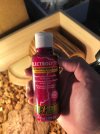

pardon me for my leghty reply,
am i doing it right or some of my routine need to adjust / change?
Roma D Irama
New Member
Noted! thank you for your reply!If you catch it when they are this little giving them the right humidity can reduce the appearance of pyramiding as they age and their shell grows. Also, make sure that to give him the healthiest foods and no fruit until adulthood. And then only very limited quantities of fruit if it's allowed on the sulcata food list.
really appriciate it.
Roma D Irama
New Member
Thank you Yvonne for the reply,in their home world (where they've evolved to live) Sulcata babies hatch out during the monsoon season. . . lots of warm, humid air, plenty of green plants and water puddling on the ground. This is NOT the desert-like environment we were told to keep them in.
So get your baby out of the desert and set him up in a warm, humid, full-of-plants environment. You can't make that pyramiding go away, but you CAN help it to not get any worse.
i am trying to get the right humidity with my set up, it is very hard to get it above 70%
(i also DIY a 7cm*4 cm* 3cm box on top of his hiding cave (circled in green in attachment) fill it with sphagnum moss to maintain the humidity)
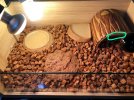
Avuwyy
Active Member
Coconut husk doesn’t tend to hold humidity well, and it can be pretty difficult to walk on for smaller tortoises. Changing your substrate could help a lot with humidity  Many people here tend to opt for coco coir and cypress mulch, though I myself can’t review its usage (I use top soil instead).
Many people here tend to opt for coco coir and cypress mulch, though I myself can’t review its usage (I use top soil instead).
Also, covering a part of the enclosure could hold in humidity also and assist in keeping humidity levels high. Since the right side of the enclosure is so open and not much is happening in regards to heating and lighting, it would be very easy to cover that with something just to ensure the humidity isn’t all escaping from the top (An idea would be something like a plastic shower curtain, or a plastic box lid).
Also, covering a part of the enclosure could hold in humidity also and assist in keeping humidity levels high. Since the right side of the enclosure is so open and not much is happening in regards to heating and lighting, it would be very easy to cover that with something just to ensure the humidity isn’t all escaping from the top (An idea would be something like a plastic shower curtain, or a plastic box lid).
All the info you need is in the care sheet, but I'll address these things one at a time for you:Hi Tom,
Thank you for your respond,
Does it considere severe pyramiding?
no it is not his/her enclousure, it's enclosure as per attachment,
that is the area where i normally bask him ofcourse with his/her enclousure as per attachment minus the lights till afternoon then i will bring him back inside and continue with artificial light uva and uvb.
I do have a night lamp at night as well.
(i also DIY a 7cm*4 cm* 3cm box on top of his hiding cave (circled in green in attachment) fill it with sphagnum moss to maintain the humidity)
due to the artificial lighting i find it very hard to keep humidity at >70%.
iam using coco husk as his subsrtate
View attachment 341415
I got him/her from a pet bazar, which i think they feed him pellets and occasionally some green vegetable before it got it.
i am switching back to pure dark green vegetable "Siomak , Fumak, dwarf elephant grass, caisim and Bokchoy"
occasionally i do feed it with some tomato / papaya (very small mount) and cactus.
Tried to feed him/her with timoty hay from (pet store for rabbits) he/she doesn't seems to like it.
i also soak him/her with warm water for 10 - 15 minutes per day, so that he/she could excreed the urates,
which is almost everyday.
Once a week i will add:
- electrolyte to his/her soaking water
- Reptical on his/her food.
View attachment 341416View attachment 341417
pardon me for my leghty reply,
am i doing it right or some of my routine need to adjust / change?
1. Coco chips are a good substrate for some species and they do hold moisture as well as anything, but those are tough for a small baby to walk on. Fine grade orchid bark works better. This has nothing to do with the pyramiding.
2. You have the wrong heating and lighting all around. All three bulbs need to go. A) You are using a spot bulb for basking, and that is a likely contributor to the pyramiding. B) No colored bulbs at night. That bulb too might be a pyramiding contributor. Use a CHE with a thermostat instead. C) CFL type UV bulbs sometimes burn their eyes and are also not effective UV sources. Replace that with an Arcadia HO tube, or get him out for real sunshine. I'll post a lighting breakdown at the end of this post.
3. Moss should not be used with tortoises. They eat it ad it can cause impaction. It does nothing that damp substrate doesn't do. I'd remove that ASAP.
4. If you can't keep humidity up, its because your enclosure is too open and has too much ventilation. Block some ventilation and humidity should rise. You may have to lower bulb wattages at the same time because reduced ventilation will also hold in more heat along with the humidity.
5. The calcium is good, but you don't need the electrolyte solution.
6. I would not feed the tortoise any tomato or fruit. The other studs sounds good, but look for more "natural" foods like weeds leaves and grasses.
7. Babies don't eat hay. I usually don't even try to introduce hay until they are over 12 inches in length. When the time come for that, don't use Timothy. Its too stemmy. Use orchard grass hay, Bermuda hay, or even better in your climate, grow real grass for you tortoise.
Read and follow that care sheet from post #2 in this thread.
There are four elements to heating and lighting:
- Basking bulb. I use 65 watt incandescent floods from the hardware store. Some people will need bigger, or smaller wattage bulbs. Let your thermometer be your guide. I run them on a timer for about 12 hours and adjust the height to get the correct basking temp under them. I also like to use a flat rock of some sort directly under the bulb. You need to check the temp with a thermometer directly under the bulb and get it to around 95-100F (36-37C).
- Ambient heat maintenance. I use ceramic heating elements or radiant heat panels set on thermostats to maintain ambient above 80 degrees day and night for tropical species. In most cases you'd only need day heat for a temperate species like Testudo or DT, as long as your house stays above 60F (15-16C) at night.
- Ambient light. I use LEDs for this purpose. Something in the 5000-6500K color range will look the best. Most bulbs at the store are in the 2500K range and they look yellowish. Strip or screw-in LED bulb types are both fine.
- UV. If you can get your tortoise outside for an hour 2 or 3 times a week, you won't need indoor UV. In colder climates, get one of the newer HO type fluorescent tubes. Which type will depend on mounting height. 5.0 bulbs make almost no UV. I like the 12% HO bulbs from Arcadia. You need a meter to check this: https://www.solarmeter.com/model65.html A good UV bulb only needs to run for 2-3 hours mid day. You need the basking bulb and the ambient lighting to be on at least 12 hours a day.
Roma D Irama
New Member
Hi Avuwyy,Coconut husk doesn’t tend to hold humidity well, and it can be pretty difficult to walk on for smaller tortoises. Changing your substrate could help a lot with humidityMany people here tend to opt for coco coir and cypress mulch, though I myself can’t review its usage (I use top soil instead).
Also, covering a part of the enclosure could hold in humidity also and assist in keeping humidity levels high. Since the right side of the enclosure is so open and not much is happening in regards to heating and lighting, it would be very easy to cover that with something just to ensure the humidity isn’t all escaping from the top (An idea would be something like a plastic shower curtain, or a plastic box lid).
thank you for your sweet respond and advise,
will definietly read up on those two definitely, my only concern is when they are dry it tend to create
dusty enviroment in their enclousure not sure if it will causes respiratory problem for the sulcata
(pardon me for my ignorance question)
Done! i covered it here is the attachment
i hope this could help maintain the humidity above 70%
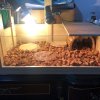
The substrate should never be dry. It should be damp all the time.Hi Avuwyy,
thank you for your sweet respond and advise,
will definietly read up on those two definitely, my only concern is when they are dry it tend to create
dusty enviroment in their enclousure not sure if it will causes respiratory problem for the sulcata
(pardon me for my ignorance question)
Done! i covered it here is the attachment
i hope this could help maintain the humidity above 70%
View attachment 341452
To hold in humidity, you need a closed chamber with the heating and lighting inside. Like these:
New Stack of Animal Plastics CLosed Chambers
AKA: Tom's baby emporium. @GStars asked for a pic on my new baby raising enclosures the other day. I only had a partial, but I took a fuller one today. Each cage is 96x30 and divided in the middle into two 48x30 cages for starting babies. The colored tape on each upper right corner shows the...
This enclosure is much too small.
Roma D Irama
New Member
Hi Tom,All the info you need is in the care sheet, but I'll address these things one at a time for you:
1. Coco chips are a good substrate for some species and they do hold moisture as well as anything, but those are tough for a small baby to walk on. Fine grade orchid bark works better. This has nothing to do with the pyramiding.
2. You have the wrong heating and lighting all around. All three bulbs need to go. A) You are using a spot bulb for basking, and that is a likely contributor to the pyramiding. B) No colored bulbs at night. That bulb too might be a pyramiding contributor. Use a CHE with a thermostat instead. C) CFL type UV bulbs sometimes burn their eyes and are also not effective UV sources. Replace that with an Arcadia HO tube, or get him out for real sunshine. I'll post a lighting breakdown at the end of this post.
3. Moss should not be used with tortoises. They eat it ad it can cause impaction. It does nothing that damp substrate doesn't do. I'd remove that ASAP.
4. If you can't keep humidity up, its because your enclosure is too open and has too much ventilation. Block some ventilation and humidity should rise. You may have to lower bulb wattages at the same time because reduced ventilation will also hold in more heat along with the humidity.
5. The calcium is good, but you don't need the electrolyte solution.
6. I would not feed the tortoise any tomato or fruit. The other studs sounds good, but look for more "natural" foods like weeds leaves and grasses.
7. Babies don't eat hay. I usually don't even try to introduce hay until they are over 12 inches in length. When the time come for that, don't use Timothy. Its too stemmy. Use orchard grass hay, Bermuda hay, or even better in your climate, grow real grass for you tortoise.
Read and follow that care sheet from post #2 in this thread.
There are four elements to heating and lighting:
Questions are welcome!
- Basking bulb. I use 65 watt incandescent floods from the hardware store. Some people will need bigger, or smaller wattage bulbs. Let your thermometer be your guide. I run them on a timer for about 12 hours and adjust the height to get the correct basking temp under them. I also like to use a flat rock of some sort directly under the bulb. You need to check the temp with a thermometer directly under the bulb and get it to around 95-100F (36-37C).
- Ambient heat maintenance. I use ceramic heating elements or radiant heat panels set on thermostats to maintain ambient above 80 degrees day and night for tropical species. In most cases you'd only need day heat for a temperate species like Testudo or DT, as long as your house stays above 60F (15-16C) at night.
- Ambient light. I use LEDs for this purpose. Something in the 5000-6500K color range will look the best. Most bulbs at the store are in the 2500K range and they look yellowish. Strip or screw-in LED bulb types are both fine.
- UV. If you can get your tortoise outside for an hour 2 or 3 times a week, you won't need indoor UV. In colder climates, get one of the newer HO type fluorescent tubes. Which type will depend on mounting height. 5.0 bulbs make almost no UV. I like the 12% HO bulbs from Arcadia. You need a meter to check this: https://www.solarmeter.com/model65.html A good UV bulb only needs to run for 2-3 hours mid day. You need the basking bulb and the ambient lighting to be on at least 12 hours a day.

Again i can't thank you enough for your advise and sweet respond.
point 2
these are the bulbs i am using
Exotera reptile UVB150 (25W),
Exotera Intense basking spot 50W
Exotera Night heat lamp 50W
So these bulb are basically wrong for the enclousure?
The enclosure size is 60CM (L) X 40CM (W) X 20CM (H)
i do monitor the temperture and hygrometer,
Daytime around basking area 32 - 34 celcius night time around 30-31 ceclcius with night heat lamp on
Daytime in the hiding cave 30.7-31 celcius Night time around 30.5 - 31.3 celcius
with humidity still lower than 70% (which i am trying at moment to get it stable at 70%)
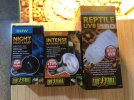
Point 3
i modify / DIY for a pocket to place the damp moss so i believe it should be safe for the torto?
i find coochusk can't maintain the moisture well even after i spray it with water,
it will lose it humidity within hours.
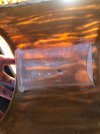

if i may ask Tom, is it a good idea to place coco coir in his hiding cave to maintain the humidity?
however my concern is, will it caused milddew or fungus to grow easily? or cause respiratory problems for sulcata?
Roma D Irama
New Member
WOW! hot damn!The substrate should never be dry. It should be damp all the time.
To hold in humidity, you need a closed chamber with the heating and lighting inside. Like these:
New Stack of Animal Plastics CLosed Chambers
AKA: Tom's baby emporium. @GStars asked for a pic on my new baby raising enclosures the other day. I only had a partial, but I took a fuller one today. Each cage is 96x30 and divided in the middle into two 48x30 cages for starting babies. The colored tape on each upper right corner shows the...tortoiseforum.org
This enclosure is much too small.
Those are a awesome enclousures!
They aren't wrong for the enclosure. They are wrong for tortoises. Spot bulbs, CFL bulbs, and colored night bulbs should not be used. Refer to the care sheet in post number two, and the lighting breakdown in post number 11 for the correct bulbs to use.So these bulb are basically wrong for the enclousure?
This is much too small even for a tiny hatchling. Minimum size for a small one is 120cxm x 60cm.The enclosure size is 60CM (L) X 40CM (W) X 20CM (H)
Basking area should be 36-37C. Your ambient and night temps are a little warm, but still good. 26C over night is best. 31-33C during the day is great.i do monitor the temperture and hygrometer,
Daytime around basking area 32 - 34 celcius night time around 30-31 ceclcius with night heat lamp on
Daytime in the hiding cave 30.7-31 celcius Night time around 30.5 - 31.3 celcius
with humidity still lower than 70% (which i am trying at moment to get it stable at 70%)
You will not be able to maintain humidity with an open top and all those hot lamps. You need a closed chamber with all the heating and lighting inside.
If the tortoise can't reach the moss and eat it, then it is safe to use, but not effective in an open mouthed cave like that. To make a humid hide, use an upside down, opaque, plastic tub, and cut out a door hole just large enough for the tortoise. Enlarge the door hole as he grows. Keep the substrate inside the hide more damp.Point 3
i modify / DIY for a pocket to place the damp moss so i believe it should be safe for the torto?
i find coochusk can't maintain the moisture well even after i spray it with water,
it will lose it humidity within hours.
Spraying the substrate does nothing as you've seen. You have to dump water into the substrate. How much water and how often varies with each enclosure, but you will never keep humidity up with an ice topped enclosure.
Coco coir holds humidity the same as any other substrate. It is drying out because you aren't putting enough water on it, and because of the hot bulbs and open top.
Coco coir in the hide is fine, but its messy. I prefer orchid bark. both of these inhibit the growth of bacteria, mold, and fungi.if i may ask Tom, is it a good idea to place coco coir in his hiding cave to maintain the humidity?
however my concern is, will it caused milddew or fungus to grow easily? or cause respiratory problems for sulcata?
Sulcatas hatch into the rainy monsoon season in Africa. Water and humidity will not make them sick as long as the temperature stays above 26C at night, and they have a warm ambient temp and a 36C basking area during the day.
